You’ve probably seen a burl, even if you didn’t know what it was. If you’ve ever noticed a large, knobby growth on a tree trunk or branch, it was probably a burl. Contrary to popular belief, it’s not harmful to the tree. In fact, burls are prized by woodworkers for their beautiful patterns.
In this article, we cover what a burl is, what it’s made out of, how it’s formed, which trees are more likely to grow burls, and what you should (and shouldn’t!) do if you find a burl in one of your trees.
WHAT IS A BURL?
A burl is a strange-looking collection of tree cells, which are called callus tissue.
Normally, callus tissue is formed by a tree in response to an environmental injury such as a pruning cut, disease, or insect damage. In forest settings, callus often arises from storm damage that has eroded away or deposited more soil around the tree’s trunk.
A typical example of callus is the tissue that rolls or closes over the edges of a good pruning cut to seal off the wound.
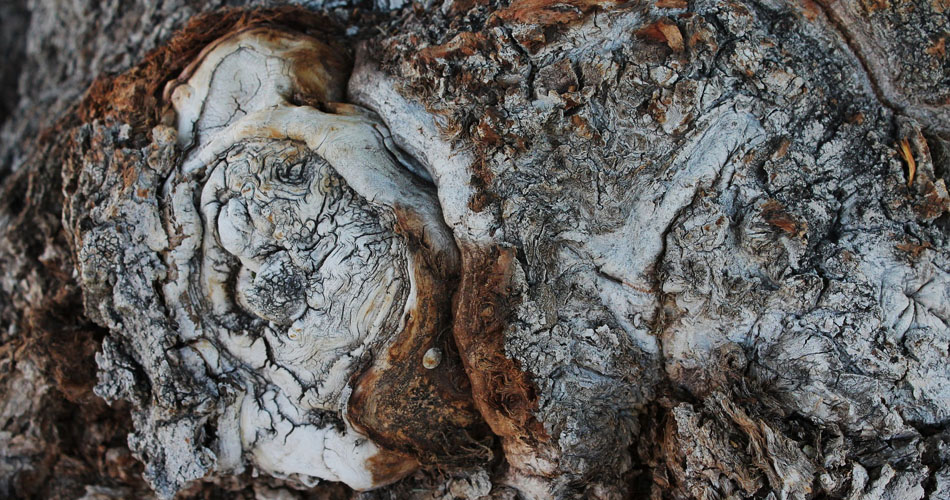
Burls develop similarly, as a protective response, but are:
- found around tree trunk bases or where branches have broken off
- found in underground tree tissue (where they are called lignotubers)
- not regulated by the same tree chemicals as callus growth, so they grow into bizarre shapes
WHICH TREE SPECIES GROW BURLS?
The towering, iconic coastal redwood of California, Sequoia sempervirens, might be the tree most immediately associated with burls, and it is certainly the main species harvested for burl used by woodcrafters.
But burls are not unique to this one species!
In addition to redwood, these well-known species are also sources for burl:
- Cherry (Prunus)
- Oak (Quercus)
- Ash (Fraxinus)
- Maple (Acer)
- Elm (Ulmus)
- Walnut (Juglans)
FUN FACT: Bird’s eye maple has a pattern that resembles a burl, but is not one.
HOW DO BURLS DEVELOP?
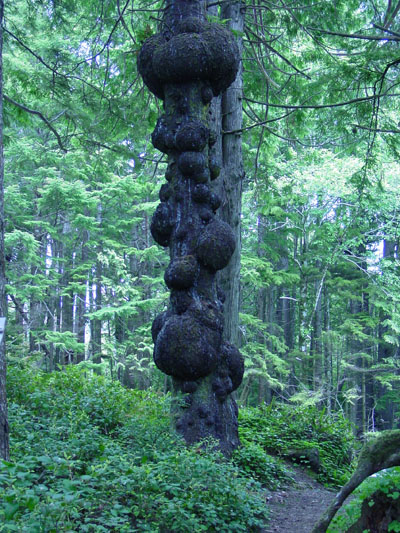
Some trees can have several burls
A burl is made up of a tree’s bud tissue that has not sprouted into foliage or grown into a twig. It has a woody or barked surface. As a burl grows, it incorporates the tree’s undeveloped buds that surround it and folds them into its expanding form.
Because these cells can grow faster than regular tree cells and can grow during all seasons, burls expand at their own rate into unpredictable sizes and appearances. In human terms, it can be compared to a fast-growing but non-malignant tumor.
Although burls grow into weird shapes and sizes on trees that otherwise look normal, a burl itself is not diseased or contagious.
The callus tissue that grows into a burl has several purposes, all related to tree growth and tree preservation. And because a tree’s burl stores the same genetic material as the tree itself, it’s a way for a tree to clone itself. For example, for coastal redwoods in their forest setting, burls can be the basis for new trees to grow from fallen or cut trees. A fallen redwood tree with burls on its trunk or branches can re-grow itself from a burl; the burl begins to sprout and forms roots and buds.
DO BURLS REALLY GROW UNDERGROUND AS WELL?
Lignotubers are burls that grow underground around a tree’s base and underneath the soil surface. They’re different from burls that grow above ground on trunks or in a tree’s crown branches, although they’re formed in much the same way.
Mainly, lignotubers grow bigger than aboveground burls – the largest lignotuber recorded (from a California redwood) was 45 feet in diameter and weighed over 500 tons!
HOW CAN I IDENTIFY A BURL?
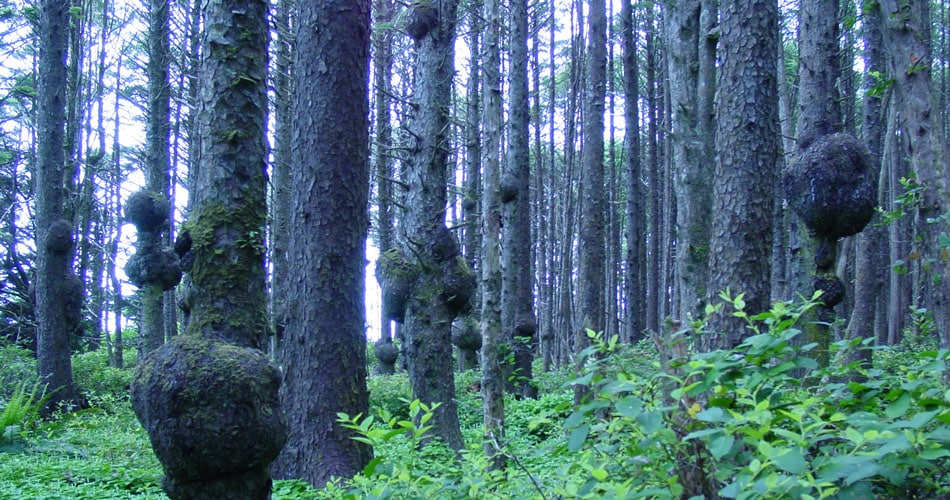
Burls on trees in a forest
Dude, if anything is gnarly, it’s a burl!
Here’s what to look for:
- areas of swelling bark,
- irregular bark patterns, and
- woody, cracking bark irregularities around a tree’s trunk or up in its branches.
If you’re uncertain whether the growth on your tree is a burl or something more serious, contact the arborists at Organic Plant Care in Flemington, NJ. If you’re in our service area, we’ll be happy to inspect the tree and diagnose the issue.
WHAT’S INSIDE A BURL?
Some people are repelled by the lumpy, twisted, irregular, and sometimes huge growths on the bark of trees. Don’t be! Think of burls as living versions of mineral geodes, where a lumpy, rocky exterior is cracked open to display striking crystal formations inside.
If you cut open a burl, you’ll find wood inside. As with sawn lumber, cutting in different directions across a burl will expose different wood grain patterns. Unlike typical tree lumber, the patterning or figuring of a burl’s wood is more complex and entirely unpredictable.
Because burls are wound response tissue, they grow where and how they “need” to in order to protect a tree. As they grow, their un-sprouted bud tissue is folded, rolled, or compressed, creating unique growth patterns within the burl. Some may even contain mineral deposits from flooded soil or air pockets and interior bark ridges from eroded areas of wood that have been incorporated into the burl.
Old burls will be made of heartwood only and are the most prized.
WHAT ARE BURLS USED FOR?
Because the pattern or grain of burl wood is so irregular and uneven and so different from straight lumber graining, burl is not used for structures or where bearing weight is required.
Burl is typically made into veneer panels, inserts, and for furniture slabs and instrument making.
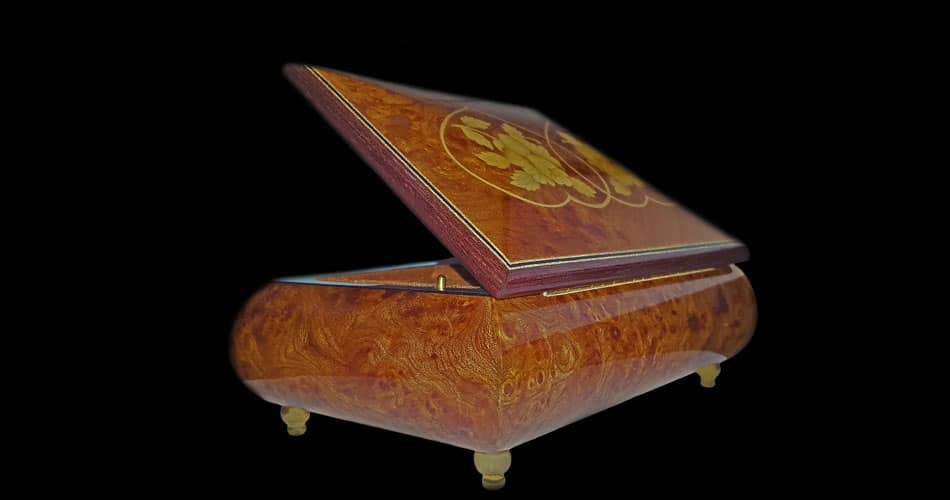
Burls are highly prized in woodworking
IS A BURL BURLY?
You bet! Aboveground burls have been documented as large as 20 feet in height and width, and weighing upwards of 20 tons; belowground ones can be much larger.
Burls of this size reflect the age that some trees attain—the tree needs to have been growing for a few hundred years or more to grow a burl that big.
THEY LOOK WEIRD. CAN I REMOVE THEM?
Please don’t! Burls may look weird, or grow to large sizes, but they have little to no effect on an otherwise healthy tree’s growth. But removing them will certainly affect a tree, and not in a good way.
Burls are a tree’s wound response used to compartmentalize or seal off injured areas. Cutting off a burl is like making a wound that the tree can’t seal off.
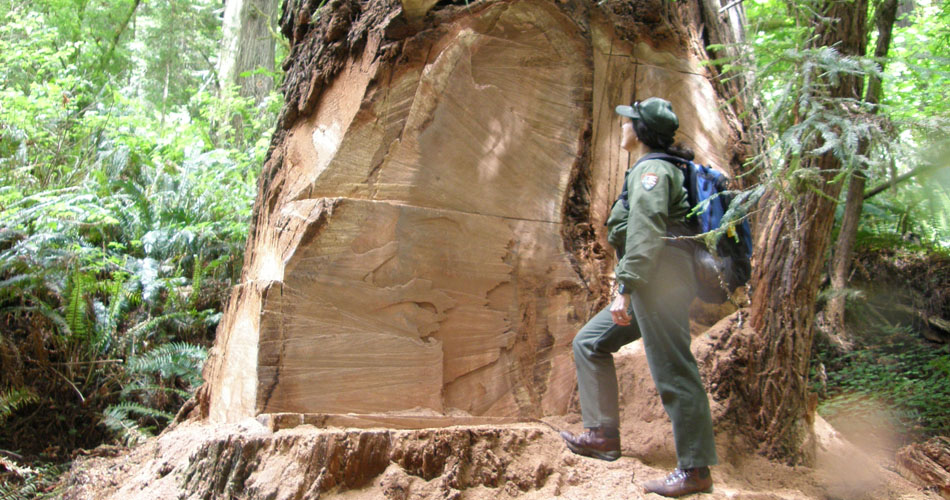
Redwood National Park, California, USA: A park ranger inspects a redwood tree that has been vandalized to steal a burl. They are the base for decorative carvings and increasingly stolen from protected redwood forests.
Remember that burls don’t have the same response chemicals as normal branch wood does, so a tree can’t close over a cut-off burl the way it can when a branch is pruned off. You’ll be left with a burl-sized wound with wood tissue that’s wide open to pests and pathogens for many seasons.
If you can’t live with burls, you’ll need to remove the entire tree and grind out its stump, rather than cutting off the burl.
If your burled tree is not healthy, or if its shape has grown to be a hazard, then certainly it should be removed. When you hire a tree care professional to remove a burled tree, be sure to ask if the burl can be evaluated and offered to a fine woodworker rather than being ground up for mulch.
But if your tree is healthy, try appreciating these fascinating gnarled growths and just let them be. The unique shape and story behind burls will make your tree the talk of the neighborhood!
GET THE LATEST NEWS
Subscribe to the Organic Plant Care Newsletter and get timely and helpful tips and updates monthly.
There's no spam - we promise!





